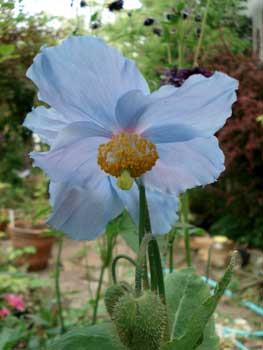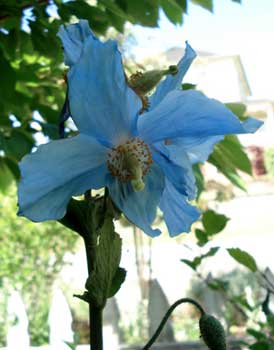
Tibetan or Himalayan Blue Poppy:
Meconopsis betonicifolia
Much like me, you make your way forward,
Walking with downturned eyes.
Well, I too kept mine lowered.
Passer-by, stop here, please.
Read, when you've picked your nosegay
Of henbane & poppy flowers,
That I was once called Marina,
And discover how old I was.
-Marina Ivanova Tsvetaeva
(1892-1941)
In a bright shade area with its root system & basal leaves more deeply shaded by surrounding perennials, we placed two clumps of Meconopsis bentonicifolia, the Tibetan Blue Poppy.(1892-1941)
These are definitely not sun-loving poppies & will do poorly in too much light. On Puget Sound they seem to like a well-protected but not too darkly shaded location. Inland, however, they'd need darker shade.
 An alpine species, native to Tibet & Yunan China, it is very cold-hardy, but not at all heat-hardy. It actually does better high up in Canada or in Alaska than on Puget Sound. The root system does not like to dry out so it needs a regularly watered location. The basal leaves & roots should never be directly sunned.
An alpine species, native to Tibet & Yunan China, it is very cold-hardy, but not at all heat-hardy. It actually does better high up in Canada or in Alaska than on Puget Sound. The root system does not like to dry out so it needs a regularly watered location. The basal leaves & roots should never be directly sunned.Good luck with them here in the Northwest does seem really to have an element of luck involved, as some gardeners lament they didn't return a second year, while others insist they did nothing special but kept them moist & shaded in rich soil & they've come back for three or four years, though not longer, it's just not in them to live longer.
So if you've had them three years, you might as well let them go to seed, as there's a chance they will self-seed, which they've been known to do in Northwest gardens that have supplemental watering through three seasons.
Ours were nursery-purchased starts but seeds are easily obtained. Growing them from seed is not easy & since I haven't done it, I won't try to describe how to go about it. But if you want to give it a try make sure the seed-source gives complete instructions, as it's not just a matter of sprinkling them in seedling soil in trays or coldframes.
The genus demands more fertilizing than other species & this should be done three times during spring & summer, then an autumn mulching of manure or other compost to keep the soil properly acidic, humusy, & moisture retentive.
Yet plant explorer Dan Hinkley (who notes that four years, if that, is the longest one can expect any given clump to flourish) has observed M. betonicifolia in its natural setting in the Himalayas, & found them even in "fully exposed rocky habitat," contrary to what is presumed to be the essentials for success in the garden.
Back in his Washington garden, he started a blue poppy bed that self-seeded successfully in a moist locatoin with half-sun. About when he'd decided their level of difficulty was exaggerated, Puget Sound had one of its rare way-too-hot summers, & the entire poppy patch got fried to death.
Thereafter Dan gave them more controlled woodland edge settings. Still, it appears that their balance of requirements may not be quite as narrow as many have decided. What makes them iffy for perennializing may just not yet be entirely well understood.
One possibility may arise from this flower seriously disliking to have its root system disturbed. So once it's in place, try not to have to move a clump. Before planting, make sure there are no grasses or grass-roots present, which could do in this uncompetitive poppy.
Another element of their unpredictability -- easy for some, impossible for others -- is the fact that the species really isn't a pure genetic strain. Seed sources grow their poppy crops in conditions that permit cross-fertilization between similar species, without any documentation as to what other species grew nearby. Virtually all blue poppies are now chance hybrids to one degree or another.
This has almost certainly led to stronger strains, & yet because the random hybridizing is continuous, a single seed source may not be producing a superior strain in every year. Still, it was not so many years ago people were insisting these poppies were extremely difficult to grow, & yet today many do have success with them, & I suspect the random hybridizing has strengthened them more than not (as well as given rise to some not-blue strains).
The leafy flower stem rises three to four feet. Numerous drooping buds appear on each stalk, & open serially, so that there are transluscent blue poppy blossoms for several weeks in May & June, despite that individually no one bloom lasts a long time.
Unlike the standard oriental poppies, the foliage does not turn nasty after blossoms are completed. It dies back in winter & (fingers crossed) returns in spring for another go. Our clumps returned for a second year but were much diminished in size.
Meconopsis as a genus are biennials, blooming their second year, then kaput. This one, however, potentially has a couple extra years in it; chances are improved by not letting it go to seed.